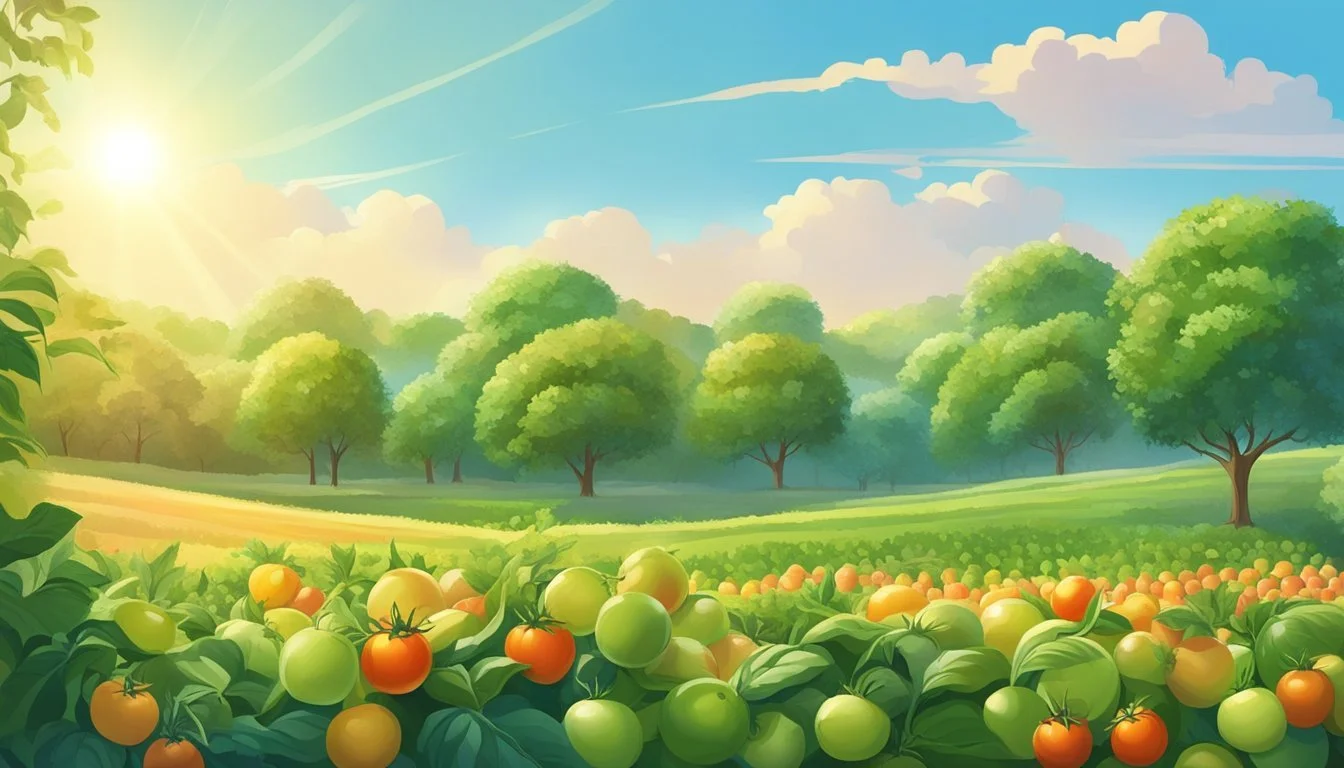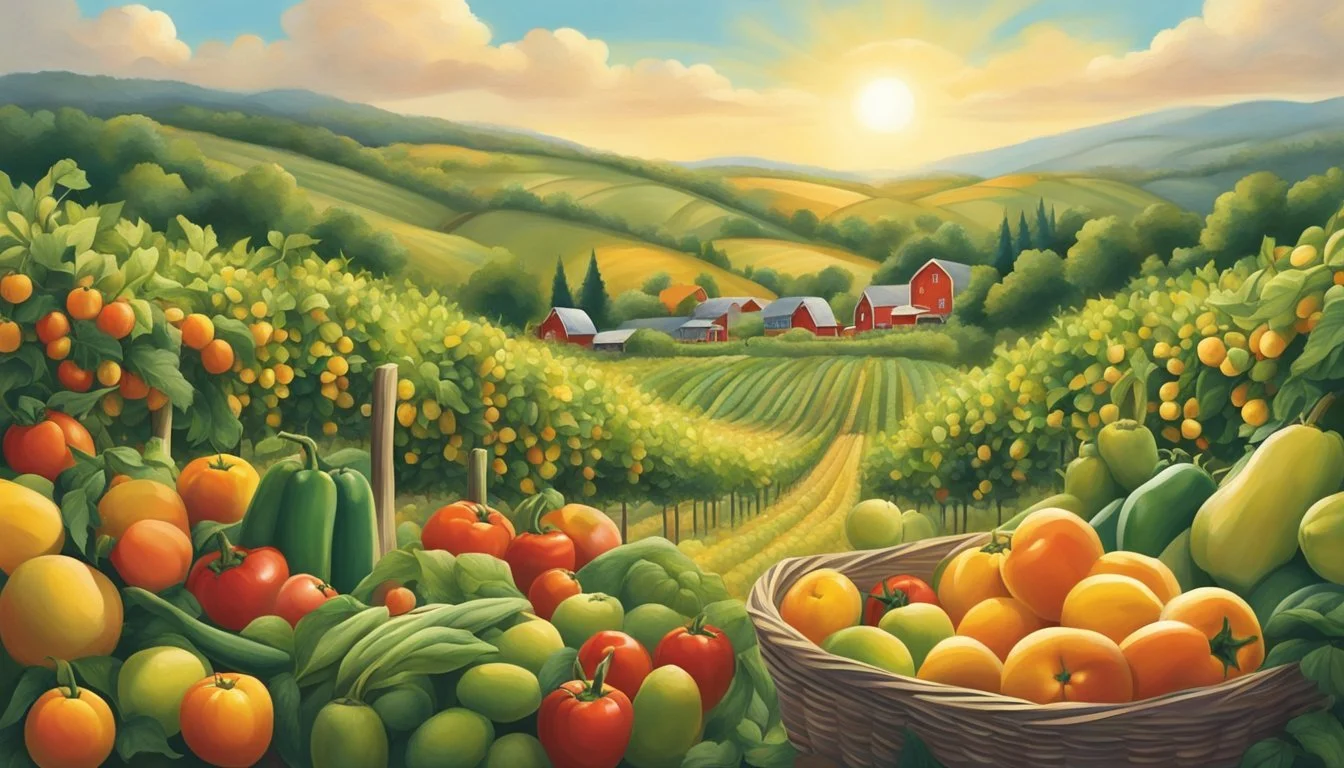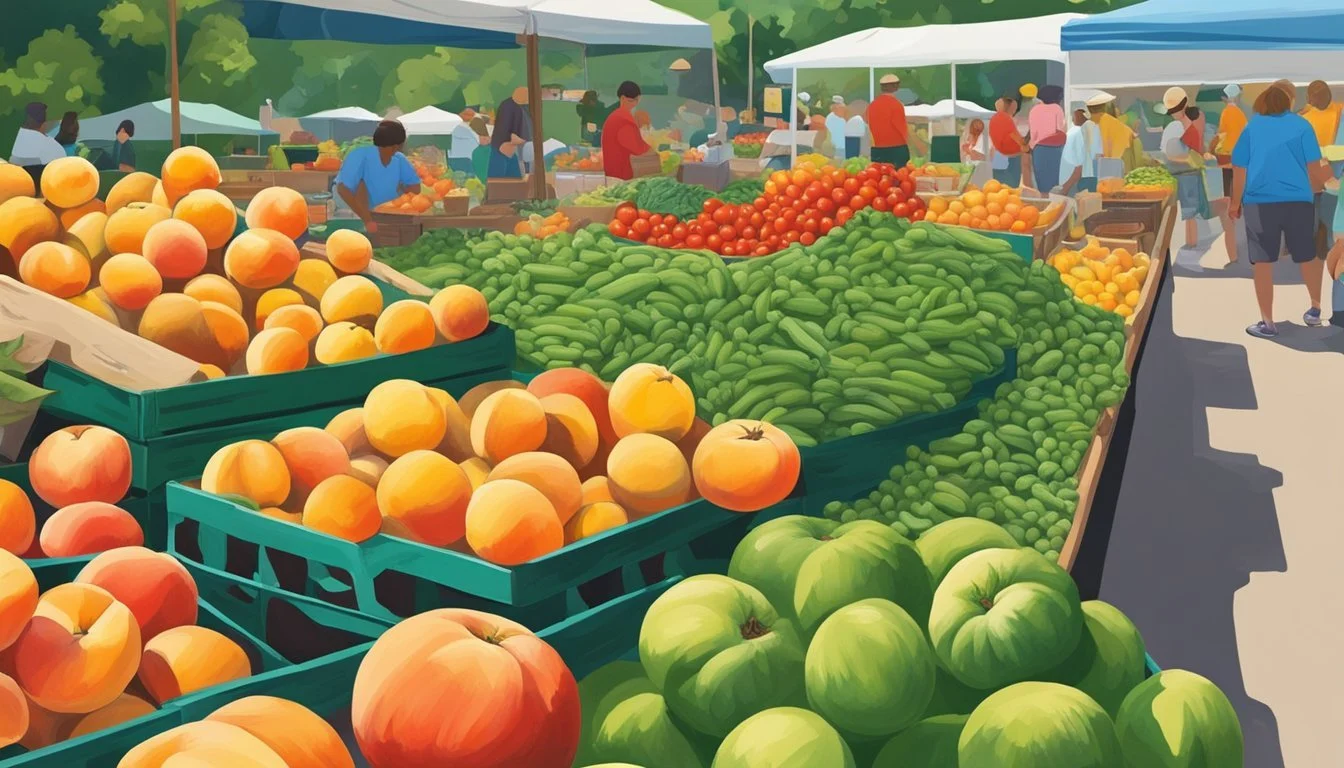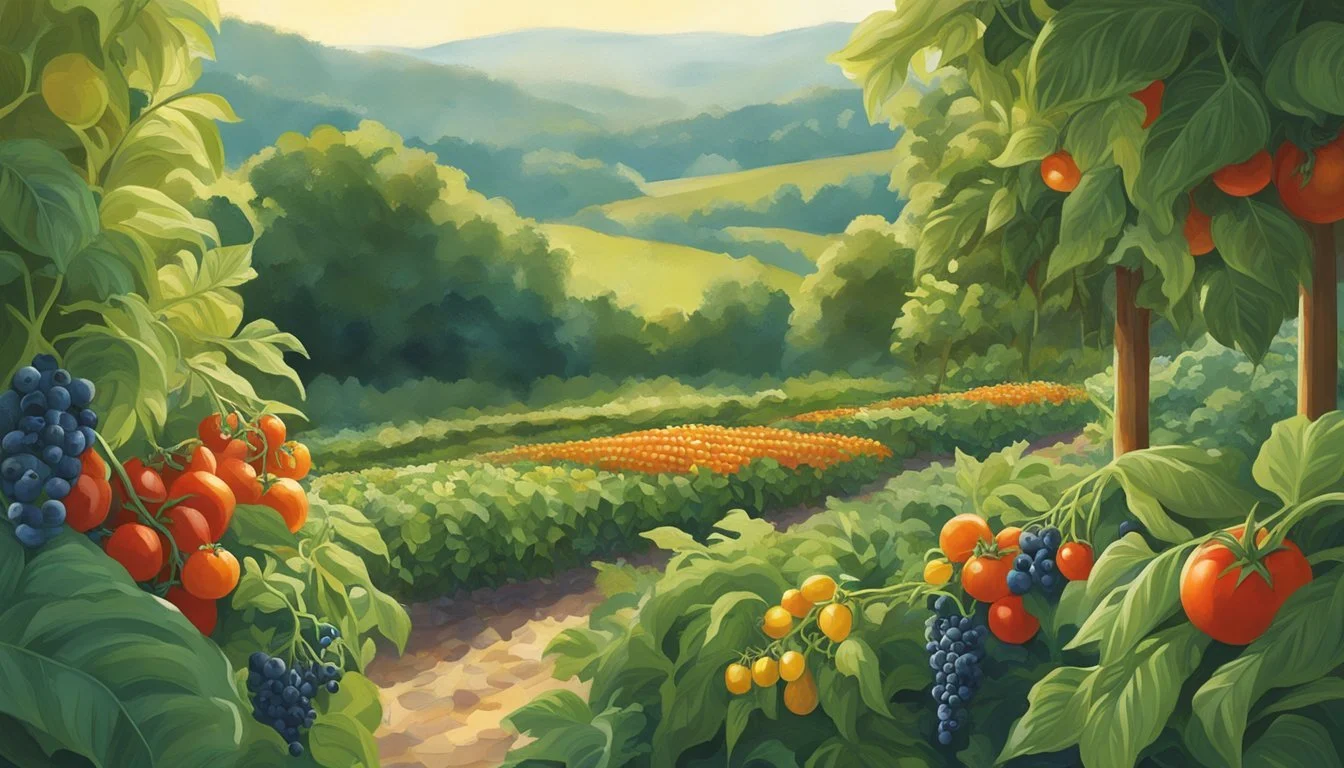West Virginia Seasonal Fruit & Vegetables in July
Your Fresh Picks Guide
This Article is Part of our West Virginia Seasonal Fruit & Veg Calendar
West Virginia's summer season brings a bounty of fresh fruits and vegetables to the tables of its residents and visitors. July, in particular, marks a period of abundance where local farmers' markets and grocery aisles are brimming with vibrant produce. The state's warm climate during these summer months coupled with rich, diverse soil conditions creates an ideal environment for growing a variety of seasonal offerings.
Among the fruits that reach their peak in West Virginia during July are raspberries and strawberries, both known for their sweet, tangy flavors and versatility. These berries are not just favorites for their taste but also for their nutritional value, packed with antioxidants and vitamins. Vegetables such as arugula also thrive in July's temperate conditions, adding a peppery note to salads and dishes.
Overall, West Virginia's July harvest is a celebration of local agriculture and the flavors it produces. With each fruit and vegetable having its own designated harvest time, the summer season is an excellent opportunity to enjoy the freshest produce while supporting local farmers and sustainable agricultural practices.
Seasonal Overview of West Virginia Produce
In July, West Virginia's agriculture offers a vibrant array of fresh produce, with many fruits and vegetables reaching their peak availability.
Understanding Crop Availability
The state's growing season progresses through several stages, influenced by the transition from spring to summer. Summer brings an abundance of warmth that supports the maturation of various fruits and vegetables. Produce such as melons, peaches, plums, berries, and a range of vegetables become readily available during this time. Here’s a list highlighting the typical crops available in West Virginia during July:
Fruits:
Melons (Cantaloupes (how long does cantaloupe last?) and Watermelons)
Peaches
Plums
Raspberries
Blackberries
Blueberries
Vegetables:
Tomatoes (What wine goes well with tomatoes?)
Cucumbers (how long do cucumbers last?)
Green Beans
Peppers
Eggplants
Squash
Zucchini
These are generally found in abundance as July sits at the heart of West Virginia's summer season, marking a key period of crop availability.
The Impact of Climate
West Virginia's climate plays a significant role in determining the growing season and the subsequent availability of crops. The state experiences a distinct four-season climate, with each contributing differently to crop production. Summer in West Virginia can be characterized by its warm and humid conditions, ideal for the growth of many fruits and vegetables. Despite variations in local climates within the state, July consistently provides optimal conditions for summer crops prior to the onset of fall.
It should be noted that while these are the typical crops available in July, weather patterns and local growing conditions can cause variability in their actual availability. It is crucial for consumers to understand that crop availability charts such as these serve as a guide but are dependent on these factors.
July's Bounty
July in West Virginia brings a wealth of fresh produce to local markets. From the sun-ripened tomatoes to the crisp green beans, the summer harvest is in full swing, providing a variety of vibrant flavors and nutritional options.
Herbs and Greens in July
In July, herbs such as basil, parsley, and cilantro are at their peak, offering fresh aromas and flavors that are ideal for enhancing summer dishes. Greens, including spinach and kale, thrive in the warm weather, offering a nutritious base for salads and side dishes.
Root Vegetables and Salad Fixings
Tomatoes and cucumbers stand out in July's root vegetable offerings. Tomatoes, both cherry and heirloom varieties, are especially juicy and flavorful, perfect for salads or fresh sauces. Cucumbers provide a refreshing crunch, essential for cool, summery salads.
Tomatoes: Cherry, Heirloom, Beefsteak
Cucumbers: Slicing, Pickling
Assortment of Summer Squash
Summer squash, such as zucchini and yellow squash, is abundant in July. These versatile vegetables can be grilled, roasted, or sautéed and are a staple in many summertime dishes. They pair well with other in-season produce like sweet corn and peppers, offering endless possibilities for creative cooking.
Squash Varieties: Zucchini, Yellow Squash
Sweet Corn: Fresh, sweet, and perfect for grilling
Peppers: Bell peppers (What wine goes well with bell peppers?) of various colors, spicy jalapeños
Fruit Harvest Calendar
In July, West Virginia's harvest calendar is rich with a variety of fruits that reach their peak ripeness. Consumers can expect both sweetness and freshness from local produce during this month.
Stone Fruits and Berries
Peaches: Ready to be picked, these juicy fruits are a staple in July. They are often at their sweetest and can be enjoyed fresh, in desserts, or preserves.
Blackberries and Raspberries: Berry picking becomes a popular activity as these berries mature. Blackberries are known for their deep flavor, while raspberries offer a tart contrast.
Berries Harvest Timeframe Blueberries Early to late July Blackberries Mid to late July Raspberries Early to mid-July
Refreshing Melons
Watermelons: Synonymous with summer refreshment, watermelons are abundant in this period. They are large, juicy, and perfect for picnics or as a hydrating snack.
Melons Harvest Timeframe Watermelons Early to late July
Fruits such as apples are not typically ready until later in the season and are not a part of the July fruit harvest calendar in West Virginia. Therefore, they are not highlighted here.
Local Market Guide
July in West Virginia offers an abundance of fresh, seasonal produce found at local markets. Here are some insights on selecting the freshest produce and supporting local farmers.
Choosing the Freshest Produce
When visiting the market, look for signs of peak freshness. In July, produce such as cherries (how long do cherries last?), peaches, and raspberries should appear bright, plump, and free of bruises or blemishes. Vegetables like bell peppers, cucumbers, and tomatoes offer a firm texture and vibrant color when at their freshest.
Fruit:
Cherries: Deep, vibrant color, firm skin
Peaches: Fragrant, slightly soft to the touch
Raspberries: Dry, firm, not mushy
Vegetables:
Bell Peppers: Glossy, taut skin
Cucumbers: Dark green, firm
Tomatoes: Bright color, slightly yielding
Supporting West Virginia Farmers
Purchasing produce at local markets supports West Virginia farmers. It ensures money spent goes directly to the growers and contributes to the local economy. Visit markets like the Morgantown Farmers Market or the Berkeley Springs Farmers Market to find a range of raw and fresh products from July until September. By choosing local options, one not only enjoys the freshest picks but also nurtures the community's agricultural roots.
Preparation and Preservation Tips
July in West Virginia marks the peak season for a plethora of fruits and vegetables. To maximize freshness and flavor, proper storage and preservation methods are essential.
Storing for Longevity
Tomatoes: Store them at room temperature away from direct sunlight to maintain their taste and texture. For longer preservation, one can freeze tomatoes or prepare them for canning to enjoy their flavor year-round.
Squash: It's best kept in a cool, well-ventilated area. One can also slice and blanch squash before freezing, ensuring a supply well into the winter months.
Corn: Preserve the freshness of corn by keeping it in the husk and storing it in the refrigerator. Freezing corn—blanched, cut from the cob—is also an effective method for long-term storage.
Peas: They should be refrigerated in a breathable bag and can be frozen after blanching to extend their shelf life.
Herbs: To maintain their aroma and taste, herbs should be refrigerated and can also be preserved by freezing or drying.
Culinary Inspirations
The bountiful produce of July presents an opportunity to create vibrant and nutritious dishes. Here’s how West Virginia’s seasonal produce can be enjoyed:
Tomatoes: Make them the star of salsas or sauces, or simply slice for a fresh salad.
Squash: Perfect for grilling, sautéing, or as a base in hearty soups.
Corn: Grilled or boiled, it's a summer classic. Corn kernels can also add sweetness to salads and salsas or be used in cornbread.
Peas: Great in salads, as a side dish, or pureed into soups.
Remember, canning is an ideal method for tomatoes and can encompass everything from sauces to whole fruits. Whether frozen or canned, the freshness of July can be savored long after summer fades.
Gardening in West Virginia
West Virginia gardeners enjoy a robust growing season that accommodates a wide variety of fruits and vegetables. This section will guide them through key planting practices and how to navigate the state's diverse climate for successful harvests.
Planting Recommendations
In July, West Virginia's gardeners should focus on planting seeds (how long do seeds last?) that thrive in the warm summer climate. This is an ideal time for sowing seeds directly into the garden soil or starting them in containers to transplant later. Key vegetables to plant include:
Green beans: Directly seed into the soil in early July.
Cucumbers: Opt for container growing to manage space efficiently.
Summer squash: Direct seed or plant young plants for a late summer harvest.
It's important for gardeners to monitor the soil temperature and moisture levels, as July's heat can sometimes require additional irrigation for optimal seed germination and plant growth.
Contending with West Virginia's Climate
The climate in West Virginia can vary considerably, which impacts gardening activities. They must be mindful of the state’s last frost date in March and expect year-to-year variations. July's main concerns are typically high humidity and heat, which can stress plants and lead to issues such as mildew or pest infestations. Gardening strategies in this climate include:
Mulching: Helps retain soil moisture and regulate temperature.
Watering: Early morning irrigation reduces evaporation and fungal diseases.
Shade cloth: Protects plants from the harshest midday sun.
A gardener's proactive steps to protect their crop during the fluctuating conditions of a West Virginia July can mean the difference between a bountiful harvest and a lost crop.








